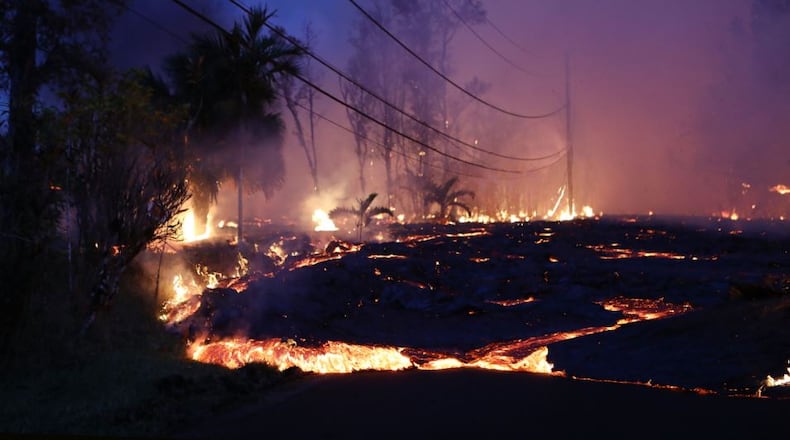Over these last two weeks I’ve been mesmerized by the lava fountains in the Puna region on the Big Island of Hawaii. My favorite is the Hawaii Volcanoes Facebook page but there are great lava videos and photos in many places. I even watch the evening news for the eruption footage.
From the questions I’ve been asked, I understand many of you are enjoying the show also.
Watching the eruptions takes me back 30 years to when Mauna Loa and Kilauea both erupted on the same day.
We were living on Oahu at the time. My husband was stationed there with the Navy.
The breaking news that morning came from the Big Island. The recent eruption of Kilauea at its new crater had been joined by an eruption of Mauna Loa which is a completely different volcano next door to Kilauea. The last simultaneous eruption had been more than 100 years before.
I cannot remember who called first, but soon my friend Lyn White, another Navy wife, and I were heading out. We had to see it. After arranging for child care, we were on the way to the airport.
It took us an hour flight to get to the airport at Hilo. Yes Hawaii is that big. The Big Island alone is around the size of Connecticut.
All afternoon we tried different ways to get up to the altitude to see the double eruption, but had no success except an enticing orange glow in the distance. The next morning we gave up and booked an expensive tourist flight over Kilauea and Mauna Loa.
Weather was better. We could see volcanic gases and steam on the horizon rising from the tops of the flat dome-shaped volcanoes. Mauna Kea, a dormant volcano, on the northeast corner of the Big Island is a snow topped composite cone shaped like we expect a volcano to look. But to its south Mauna Loa and Kilauea are shield volcanoes, which are shaped more like flat turtles than mountains.
Geology had been my minor in college and I’d hiked on volcanoes in Iceland and Sicily, but nothing prepared me for this.
The flight in the little two engine Cessna started to get bumpy as we approached the eruption sites. We had been climbing constantly since we left the airport and were nearly a mile high although we looked to be only 500 feet from the ground. The heat rising off the 2000 degree lava fountains was causing turbulence. Our pilot got as low as he could legally and headed between the fountains.
On the left side of our little airplane Kilauea was shooting bright orange lava up a thousand feet out of its Puu’O’o vent. On the right side of the airplane we could see lava fountaining in a continuous 300 foot high wall of lava called a curtain. This curtain followed a fissure and was nearly a mile long. The lava in the heavy curtain fell continuously into a long pool of lava that overflowed into a red glowing river that curled toward Hilo 17 miles away.
In the cockpit the windows on both sides were warm from the eruptions. I used up my entire roll of film in two minutes then just stared agape at this spectacular display.
Yes, it seems trite now to call the scene below “other worldly”, but that is about all you can call it. The tops of both volcanoes were dark lava covered wastelands. The lush tropical forests that had grown on the gently sloped sides of the mountains were being flooded and bulldozed by shiny black lava flows tinged with orange and red lava on the edges. Trees stuck out of the lava field and burned like torches, and steam belched from the cracks in the surface.
To the untrained eye the fountains looked like neon orange water splashing up, but in reality the fountains were made of rock, a dense moving fluid rock being shot into the air by the tremendous pressure of steam, and toxic gases. The roar of the volcano’s vents could be heard above the airplane engine noise.
Over the next five years my husband and I visited the moon like landscape around the volcanoes many times. Mauna Loa had fallen back to sleep and Kilauea’s eruption continued out of a lower crater which was making new land where lava met the sea.
This is all a lesson to us. The earth is always changing. In Hawaii change can happen quickly with a lava flow, a tsunami, or an earthquake. Here it is slower with erosion, but it still happens. The Earth changes. Nothing stays the same forever. Enjoy the show.
About the Author
